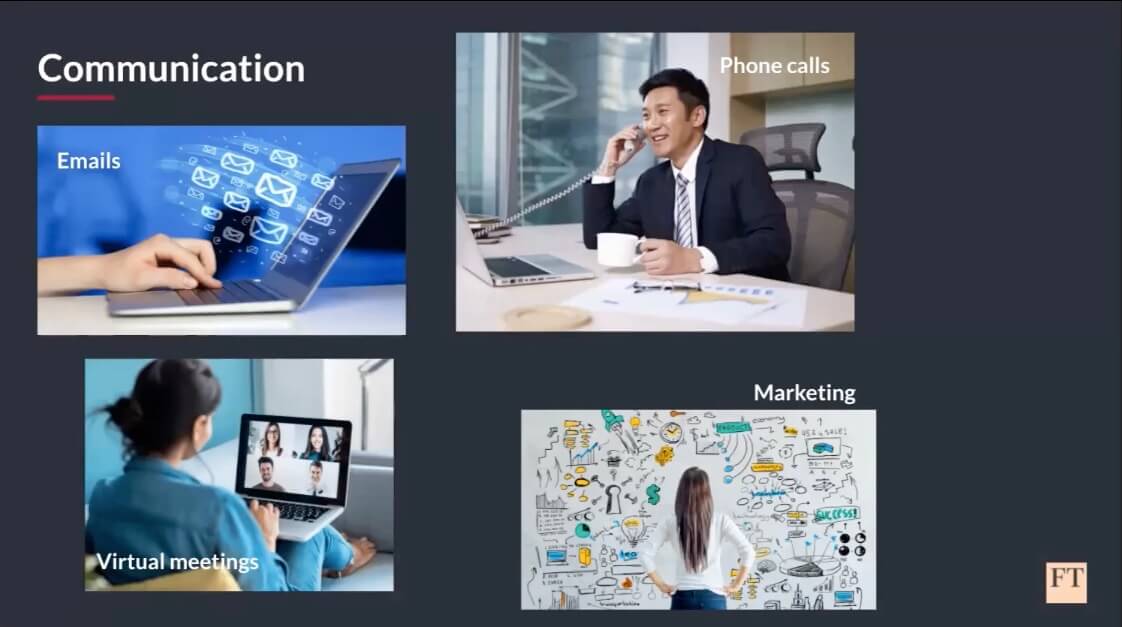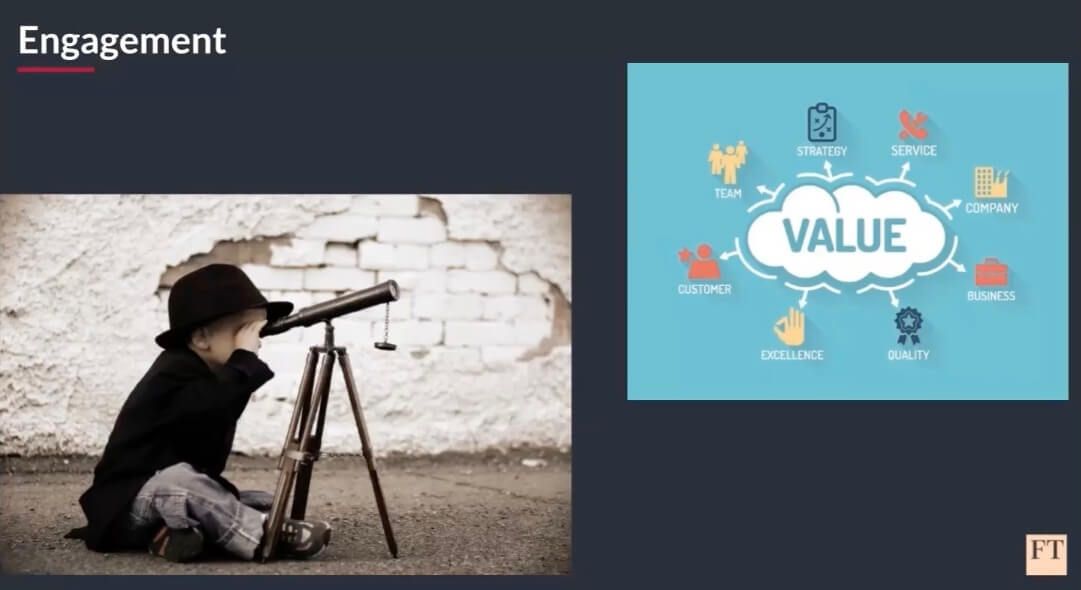My name is Lawrence Ang, and I work with the customer success team at The Financial Times. In this article, I’ll be focusing on customer communications and engagement. Obviously, I’m basing this very heavily on my own experiences, but there are certainly variations for different people.
But there are some pretty fundamental rules of thumb that work the vast majority of the time.
The two crucial elements are communication and engagement. Just for fun, I’ve decided to substitute these elements with movie quotes, so here are the main talking points for this article.
- Customer success at The Financial Times
- You had me at 'hello': communication
- You had my curiosity, but now you have my attention
- Tips and tricks
But before we dig into the main subject of this article, let me give you a bit more background on myself and my work at The Financial Times.
Customer success at The Financial Times

So, I know what you must be thinking, “why does The Financial Times need a customer success team anyway?” Truthfully, I was wondering exactly the same thing when I was approached for this role.
The Financial Times is a UK publication that is now part of Nikkei Inc. We're known for opinion pieces, but also for factual news. Whatever you read there, you don't have to fact-check anywhere else.
What we do at The Financial Times
I don't want to sound too commercial. Don’t worry, I'm not trying to sell you anything! But the fact is, we do have 700 journalists around the world in 40 countries. The team that I’m in is part of the B2B digital team, and we work with corporate customers.
We provide digital access to businesses, governments, education institutions, allowing them access to content behind a paywall. I think the customer success team here functions just like any other SaaS-based tech company, it's just that the product that we're selling is slightly different.
Our customer success goals
Like most customer success teams, we have quarterly goals that we always try to achieve. Our goal is always to acquire and retain new customers. The acquisition is pre-sales work. Some of the pre-sales work I might do involves presenting a demo to a potential customer.
I also focus on onboarding, health checks, renewal conversations, and trying to gather user feedback. All things that will be relevant to you in your organization.
You had me at 'hello': communication in customer success

Barriers to communication
How do you start a conversation? How do you communicate with your customers? This is what I’ve been focusing on with my users at The Financial Times. Obviously, your go-tos are gonna be emails, phone calls, and virtual meetings.
Now, we know that in-person meetings are obviously ideal, but in this current situation, we’re having to rely on virtual meetings. Clearly, when you're trying to communicate new content updates, product updates, or just checking in with customers, virtual meetings can get the job done.
But when you’re dealing with something more sensitive like onboarding sessions, I find that virtual meetings just aren’t up to the task. You need that spontaneous environment, that back and forth conversation.
We also send a lot of emails offering trials and sending surveys that gather feedback from the trial list. But we didn't really get that much feedback from them. People tend to ignore emails, especially if there is no urgency for a reply.
How do we overcome those barriers?
We found that if we kept the emails simple, with maybe only three questions, we actually got a lot more replies from these customers. Three is the magic number.
A survey conducted by Litmus concluded that the average person spends only 13.4 seconds reading an email. When you think about that, it doesn’t really make a lot of sense to send out a five-page email.
A survey conducted in the UK concluded that the average attention span of a person in a meeting is about 14 minutes long. With this in mind, it really drives home, how important it is to create a spontaneous, engaging environment for meetings.
Who are you trying to communicate with?
So, how long do you want your email to be? How long should your virtual meeting be? Well, this really revolves around who you are trying to contact. Also, what is the level of contact you're trying to reach?
The kind of rollout you want to have will determine how you want to structure your email and how you want to communicate with users or orgs. You need to have a goal in mind when you’re trying to reach out to them.
What's the goal of having this call with your customer?
More importantly, how should you communicate with your customers?
There’s no definitive answer, but think along these lines 👇

Put yourself in your customer’s shoes
I will always put myself in their shoes and try to understand what is the appropriate kind of messaging. What would I be more prone to reply to?
What would keep me reading an email? What did I say to you earlier? “I’m not trying to sell you anything.” Did it keep you reading? Even a simple line like this at the start of an email can keep a person reading. How do you make people lower their defenses to you? In my job, we’re gonna have to make a lot of calls. And some of them are gonna be cold calls.
Lower defenses
I’m sure everyone reading this has received credit card company cold calls. You know how it goes, most of the time you're just telling them you’re not interested. You’re too busy now. I’ve found that the reason for this is that the caller is just reading off a script, going at machine-gun speed. They’re not letting you absorb anything that they're saying.
But if you take it slow, starting with just introducing yourself, where you're calling from and what you're trying to do, I think this allows them to absorb your message a bit better. And rather than just brush it off right away, they sometimes still give you a bit of time to speak to them.
Understand the customer’s business
Also, try to understand the customer's business. What are their goals? What are they trying to achieve?
Putting this into your conversation will actually help. I think a lot of customers will appreciate the fact that you took the time and the trouble to actually understand the business. But above all else, just be yourself, be personable, be remarkable. And some people feel that this is someone that's worth connecting with.
You had my curiosity, but now you have my attention: engagement
So you've got your foot in the door, but what's next? How do you maintain that relationship?
How do you keep them constantly engaged?

Reach out to users and stakeholders
At The Financial Times, the people that we have to communicate with would include the end-users or the stakeholders.
And when I say stakeholder, these are the decision-makers who decided to invest in a subscription with a Financial Times license. These are people who are just managing the subscription for the organization. They’re people within the admin departments, library resource team, or even the learning and development team within the organization itself.
We try to engage with them, and we try to help them understand what they want to achieve at The Financial Times, or at least try to align with their business goals. How do we keep them interested? What are the different ways that we can reach out to them?
Users
Understanding customer values and goals
My overall understanding of what engagement is is to try to help customers see the value of the investment in The Financial Times, as well as the value of keeping in touch with the customer success team.
I repeatedly told you that understanding the customer's organization objectives and the individual user's goals would be very helpful. With end-users, when trying to understand what kind of information they are looking for, we will try to recommend content to them based on that information.

Make suggestions and recommendations
You can even make suggestions based on what similar users in similar industries are interacting with. We look at how users are using The Financial Times, and we try to help them incorporate it into their daily workflow, making it easier for them to find the information they need.
Even just the simple task of checking if they're able to access their accounts is worthwhile. Sometimes it's just because they're not tech-savvy. Maybe they forgot their password.
Maybe they don't know how to reset the password. People tend to just forget their passwords, or they forget that they’ve even got an account with you to begin with. We’re trying to find advocates, people who will help us sell The Financial Times within the organization itself.
License admins
These are people who are just managing the subscription for the organization. They’re concerned with whether the users are able to get access to The Financial Times.
We usually use data to show them that the users are engaging with The Financial Times. As long as they see their users are using it, they’ll be satisfied, especially when it comes to renewal.
The stakeholders
You have to understand what drives them. What are they concerned about? Why did they actually initially initiate the conversation or invest in The Financial Times. This is also about using data to show them that their users are actually getting value from this.

Constant engagement
So for customer engagement, here are some ideas that we as a customer success team at The Financial Times have tried out. And these are the ones that I'm showing to you because they worked for me.
Call an article discussion
So, what is an article discussion?
Our management team asked us to find an article within The Financial Times or any other publication, and use that article to start a conversation with any of our users or accounts. Initially, it was kind of scary, because we're going to go into territory that we're not necessarily sure of. This was an experiment.
I was pleasantly surprised that quite a number of people actually replied to my email. And they were really passionate, even when they didn’t agree with the article. Because either way, you’ve engaged your customer in conversation. And that actually helps to establish some relationship with the customer.

In gauging customer likes and dislikes, you’re able to better serve your users, and learn about what kind of material they might be interested in engaging with in the future.
Use events
We have these events at FT called FT Life. Usually, these are paid events, but once in a while, our team is able to get their hands on free tickets. We will use these events to reach out to our super readers of FTP, and we will ask them if they’re interested in attending these events, we can sometimes get them free tickets.
It also helps us to start a conversation with them. Once they attend the event, we can also follow up just to see how they are and start a conversation with them.
Tips and tricks
Effective onboarding
I’ll begin this with an anecdote. I was buying this item from a particular vendor and it took a few weeks for them to actually deliver it to me. One week before the item was delivered, they sent out an email to me asking if I wanted to book an appointment with the product expert, who will show me how this product can be better leveraged.
This is a very good idea, especially for our new users or people who are just renewing their licenses. I can make it so users can book an onboarding session with us, and get to know certain things before the subscription starts. They can hit the ground running and start using it.
Productive engagement
This is where customer success managers in different companies use different software to book appointments with the customers.
This software allows you to just create a link and let your users access your calendar. They can then directly book a slot on your calendar themselves. I decided to just put this link in our email signature, allowing them to access our calendar at any point in time.
They can just book the appointment with us whenever they need to, instead of multiple emails back and forth. I've found that I now have more people booking engagements with me and booking onboarding sessions with me.
Key takeaways
- Personalize your message. Make it about your customers and not your product. That will really help with your research on who they are.
- Try to have more constructive conversations with your users. This will help you to get an idea of what their needs are.
- Be open-minded. try out different ideas, different techniques on how to communicate with customers. How do you retain engagement customers? look at how other companies are doing it. Look at how your other colleagues in different regions are doing it.



 Follow us on LinkedIn
Follow us on LinkedIn



